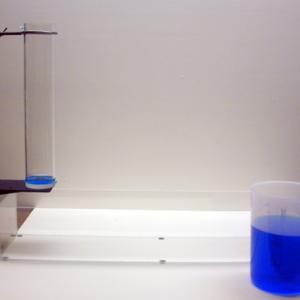College of Liberal Arts & Sciences
2C10.10 - Three Hole Can Experiment - Velocity of Efflux
Video Credit: Jonathan M. Sullivan-Wood.
Mount the Plexiglas column on the platform at a height so that the water will shoot into the catch basin. Fill the column with water and observe the Pressure vs. Water Head Height relationships as demonstrated by the water streams.
- John H. Lienhard V, John H. Lienhard IV, "Comment on "Measurement of Gravitational Acceleration Using Bernoulli's Equation"", TPT, Vol. 62, #6, Sept. 2024, p. 421.
- Taehun Jang, Sang Ho Sohn, Hyejin Ha, Siwoo Kwon, Gyeongmo Lee, Donggeon Lee, Yeongjun Lee, Seo Woo Park, Jun Young Jang, Jungbin Kim, Seong Eun Kwak, Junghwa Kim, "Measurement of Gravitational Acceleration Using Bernoulli's Equation", TPT, Vol. 62, #4, April 2024, p. 268.
- Hollis Williams, "Vessel Drainage Under the Influence of Gravity", TPT, Vol. 59, #8, Nov. 2021, p. 629.
- Milena D. Davidovic, Tatjana Markovic-Topalovic, Josip Slisko, Mirjana Bozic, "Visualizing Properties of a Quadratic Function Using Torricelli's Fountain", TPT, Vol. 58, #4, April 2020, p. 263.
- Georgios M. Horsch, "A Simple Model for the Calculation of the Fluid Discharge from a Small Orifice", TPT, Vol. 58, #2, Feb. 2020, p. 113.
- Laura Pavesi, "Investigating Torricelli’s Law (and More) with a 19th-Century Bottle", TPT, Vol. 57, #2, Feb. 2019, p. 106.
- Vjera Lopac, "Water Jets from Bottles, Buckets, Barrels, and Vases with Holes", TPT, Vol. 53, #3, Mar. 2015, p. 169.
- Ashley Hicks and William Slaton, "Determining the Coefficient of Discharge for a Draining Container", TPT, Vol. 52, #1, Jan. 2014, p. 43.
- Stephen J. Fairman, Joseph A. Johnson, and Thomas A. Walkiewicz, "Fluid Flow with Logger Pro", TPT, Vol. 41, #6, Sept. 2003, p. 345.
- Richard E. Berg, "More Leaky Buckets", TPT, Vol. 29, #5, May 1991, p. 266.
- Lawrence Ruby, "If You Understand Leaky Buckets, You Understand a Lot of Physics", TPT, Vol. 29, #1, Jan. 1991, p. 44.
- Earl Zwicker, "Doing Physics", TPT, Vol. 25, #1, Jan. 1987, p. 59.
- R. D. Edge and Samuel Derman, "Light Pipes, Hydrostatics, Surface Tension and a Milk Carton", TPT, Vol. 22, #1, Jan. 1984, p. 42.
- Lance Breger, "A Simplified Derivation of Bernoulli's Equation of Hydrodynamics", TPT, Vol. 20, #4, Apr. 1982, p. 248.
- E. J. Ansaldo, "On Bernoulli, Torricelli, and the Syphon", TPT, Vol. 20, #4, Apr. 1982, p. 243.
- Roy H. Biser, "The Water Can Explored Again", TPT, Vol. 4, #7, Oct. 1966, p. 304.
- Lester G. Paldy, "The Water Can Paradox", TPT, Vol. 1, #3, Sept. 1963, p. 126.
- D. Alvaro-Berlanga, R. Planet, A. Fernandez-Nieves, "Torricelli's Experiment and Conservation of Momentum", AJP, Vol. 92, #7, July 2024, p. 493.
- Martı́n Eduardo Saleta, Dina Tobia, and Salvador Gil, "Experimental Study of Bernoulli's Equation with Losses", AJP, Vol. 73, #7, July 2005, p. 598.
- "F-045.Torricelli's Column", DICK and RAE Physics Demo Notebook, 1993.
- G. D. Freier and F. J. Anderson, "Fk-2", A Demonstration Handbook for Physics.
- Tik Liem, "13.26. The Squirting Water Holes", Investigation to Science Inquiry.
- Robert Ehrlich, "H.4. Speed Variation of Water Flowing out of a Hole in a Can", Turning the World Inside Out and 174 Other Simple Physics Demonstrations, p. 99 - 100.
- Robert Ehrlich, "H.3. Three Holes in a Water-Filled Bottle", Turning the World Inside Out and 174 Other Simple Physics Demonstrations, p. 98 - 99.
- Charles Vivian, "How Water Spurts", Science Experiments and Amusements for Children, p. 9.
- Martin Gardner, "Three Jets", Science Tricks, p. 17.
- "Tie a Knot in Water", The Usborne Book of Science Experiments.
- Christopher P. Jargodzki and Franklin Potter, "90. Three-Hole Can", Mad About Physics, p. 31, 178.
- Julius Sumner Miller, Q176 & A176, Millergrams II – Some More Enchanting Questions for Enquiring Minds, p. 44 & 99.
- Joseph Frick, "#125 - Velocity of Efflux", Physical Technics: Or, Practical Instructions for Making Experiments in Physics and the Construction of Physical Apparatus with the Most Limited Means", p. 154.
- "Vessel", Pike's Illustrated Catalogue of Scientific & Medical Instruments, 1984, p. 239.
- The Queen Catalogues Vol. II, Catalogue of Physical Instruments, No. 4220, p. 25.
Disclaimer: These demonstrations are provided only for illustrative use by persons affiliated with The University of Iowa and only under the direction of a trained instructor or physicist. The University of Iowa is not responsible for demonstrations performed by those using their own equipment or who choose to use this reference material for their own purpose. The demonstrations included here are within the public domain and can be found in materials contained in libraries, bookstores, and through electronic sources. Performing all or any portion of any of these demonstrations, with or without revisions not depicted here entails inherent risks. These risks include, without limitation, bodily injury (and possibly death), including risks to health that may be temporary or permanent and that may exacerbate a pre-existing medical condition; and property loss or damage. Anyone performing any part of these demonstrations, even with revisions, knowingly and voluntarily assumes all risks associated with them.

